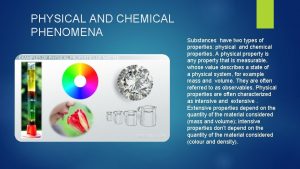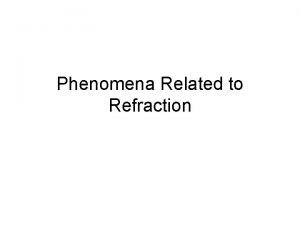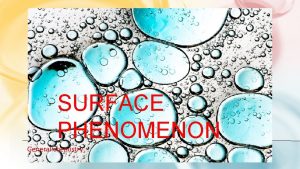Introduction to the colloid chemistry and surface phenomena



















- Slides: 19

Introduction to the colloid chemistry and surface phenomena _____________________________________________ This project has been funded with support from the European Commission. This publication reflects the views only of the authors, and the Commission cannot be held responsible for any use which may be made of the information contained therein.

Examples of colloidal systems and surface phenomena from daily life How detergents really clean? And why this “milky” colour that milk has? Why do mosquitos and other small insects can walk on water? Why does Ouzo’s colour change Why the leaves of _____________________________________________ Why do we so often use eggs for from transparent to cloudy when lotus possess self______ This project has been funded with support from the European Commission. This publication reflects the views only making sauces? the authors, and the Commission cannot be held responsible for any use property? which may be made of the information we ofcontained add water? cleaning therein.

More examples of colloids _____________________________________________ This project has been funded with support from the European Commission. This publication reflects the views only of the authors, and the Commission cannot be held responsible for any use which may be made of the information contained therein.

_____________________________________________ This project has been funded with support from the European Commission. This publication reflects the views only of the authors, and the Commission cannot be held responsible for any use which may be made of the information contained therein.

Colloid science is both a multi- and interdisciplinary topic • • • Physical chemistry Physics Biology Medicine Materials Microelectronics Dialysis Truly valuable to chemists, chemical engineers, biologists, material and food scientists and many more. _____________________________________________ Microemulsion synthesis This project has been funded with support from the European Commission. This publication reflects the views only of the authors, and the Commission cannot be held responsible for any use which may be made of the information contained therein.

Definition of colloidal systems • Finely-divided dispersion of one phase in another. • It concerns, in the main, systems containing large molecules and/or small particles. • The adjective 'microheterogeneous' provides an appropriate description of most colloidal systems. • There is, however, no sharp distinction between colloidal and non-colloidal systems. _____________________________________________ This project has been funded with support from the European Commission. This publication reflects the views only of the authors, and the Commission cannot be held responsible for any use which may be made of the information contained therein.

What are the colloids and interfaces? Why do we study them together? Colloidal dispersions are systems of particles or droplets with the “right dimensions” (the dispersed phase), which are dispersed in a medium (gas, liquid or solid). But which are the “right dimensions”? The link between colloids and surfaces follows naturally from the fact that particulate matter has a high surface area to mass ratio. _____________________________________________ This project has been funded with support from the European Commission. This publication reflects the views only of the authors, and the Commission cannot be held responsible for any use which may be made of the information contained therein.

Surface matters Their high interfacial area is the reason why colloidal systems have special properties and also why we study colloids and interfaces together. The characteristic properties of colloidal systems are due to the size of the particles or droplets (i. e. the dispersed phase), and not to any special nature of the particles _____________________________________________ This project has been funded with support from the European Commission. This publication reflects the views only of the authors, and the Commission cannot be held responsible for any use which may be made of the information contained therein.

Another example • 1 litre of a latex paint suspension containing 50% solids with a particle size of 0. 2 μm has a total particle surface area of 15000 m 2. • However, to form such huge interfaces, e. g. by dispersing water in the form of droplets in an oil, we need “to do a lot of work”. _____________________________________________ This project has been funded with support from the European Commission. This publication reflects the views only of the authors, and the Commission cannot be held responsible for any use which may be made of the information contained therein.

Colloids and interfaces An interface has a thickness of afew ångstrøm _____________________________________________ This project has been funded with support from the European Commission. This publication reflects the views only of the authors, and the Commission cannot be held responsible for any use which may be made of the information contained therein.

Why are colloids important? • It is a highly interdisciplinary subject, of interest to diverse fields of science and engineering. • Just to mention a few: pharmaceuticals, food, cosmetics, detergents, medicine and biology, up to materials and microelectronics. _____________________________________________ This project has been funded with support from the European Commission. This publication reflects the views only of the authors, and the Commission cannot be held responsible for any use which may be made of the information contained therein.

Some applications _____________________________________________ This project has been funded with support from the European Commission. This publication reflects the views only of the authors, and the Commission cannot be held responsible for any use which may be made of the information contained therein.

Three ways of classifying the colloids • Colloids (or colloidal dispersions) can be classified according to the state of the dispersed phase and the dispersion medium (gas, liquid, solid). _____________________________________________ This project has been funded with support from the European Commission. This publication reflects the views only of the authors, and the Commission cannot be held responsible for any use which may be made of the information contained therein.

Classification _____________________________________________ This project has been funded with support from the European Commission. This publication reflects the views only of the authors, and the Commission cannot be held responsible for any use which may be made of the information contained therein.

Lyophobic and Lyophilic • Lyophobic (i. e. solvent hating) colloids are those in which the dispersoid (dispersed object) constitutes a distinct phase. • Lyophobic colloids are thermodynamically unstable. • Lyophilic colloids refer to single-phase solutions of macromolecules or polymers. • These terms describe the tendency of a particle (in general a chemical group or surface) to become wetted/solvated by the liquid. _____________________________________________ This project has been funded with support from the European Commission. This publication reflects the views only of the authors, and the Commission cannot be held responsible for any use which may be made of the information contained therein.

How to prepare colloid systems? • Basically, the formation of colloidal material involves either degradation of bulk matter or aggregation of small molecules or ions. • Dispersion of bulk material by simple grinding in a colloid mill or by ultrasonics • Aggregation methods involve the formation of a molecularly dispersed supersaturated solution from which the material in question precipitates in a suitably divided form. _____________________________________________ This project has been funded with support from the European Commission. This publication reflects the views only of the authors, and the Commission cannot be held responsible for any use which may be made of the information contained therein.

Key properties of colloids • They have very interesting kinetic, rheological and optical properties. • The van der Waals attractive forces in colloids are much stronger than those between molecules and lead to aggregation (instability), but there are (fortunately) also repulsive electrical forces, when the particles are charged, which ”help stability”. • There are other types of repulsive forces, e. g. steric, solvation. • Almost all lyophobic colloids are in reality metastable systems. • When we use the term “stable” colloids, we imply a kinetically stable colloid at some arbitrary length of time (which can be, forexample, two days or two years). _____________________________________________ This project has been funded with support from the European Commission. This publication reflects the views only of the authors, and the Commission cannot be held responsible for any use which may be made of the information contained therein.

Author, Editor and Referee References This remote access laboratory was created thanks to work done primarily at University of Niš. Contributors to this material were: Marjan Ranđelović Refereeing of this material was done by: ___________ Editing into NETCHEM Format and onto NETCHEM platform was completed by: Milan Milosevic, Tatjana Andjelkovic _____________________________________________ This project has been funded with support from the European Commission. This publication reflects the views only of the authors, and the Commission cannot be held responsible for any use which may be made of the information contained therein.

References and Supplemental Material The NETCHEM platform was established at the University of Nis in 2016 -2019 through the Erasmus Programme. Please contact a NETCHEM representatives at your institution or visit our website for an expanded contact list. The work included had been led by the NETCHEM staff at your institution. _____________________________________________ This project has been funded with support from the European Commission. This publication reflects the views only of the authors, and the Commission cannot be held responsible for any use which may be made of the information contained therein.
 Which are not purely surface phenomena
Which are not purely surface phenomena Surface and interfacial phenomena
Surface and interfacial phenomena Ppt on some natural phenomena class 8
Ppt on some natural phenomena class 8 Physical and chemical phenomena
Physical and chemical phenomena Phenomena vs noumena
Phenomena vs noumena Hammer mill principle
Hammer mill principle Solutions, suspensions and colloids activity
Solutions, suspensions and colloids activity Crystalloid fluids examples
Crystalloid fluids examples Volume and surface area of cone
Volume and surface area of cone What is the lateral area of a triangular prism
What is the lateral area of a triangular prism Passer-by monikko
Passer-by monikko Phenomena related to refraction of light
Phenomena related to refraction of light Observable phenomenon
Observable phenomenon Objective phenomena
Objective phenomena Natural language processing
Natural language processing Reference phenomenon in nlp
Reference phenomenon in nlp Gravitation is a natural phenomenon where:
Gravitation is a natural phenomenon where: Carrier transport phenomena
Carrier transport phenomena Anchor phenomenon
Anchor phenomenon Observable phenomenon
Observable phenomenon





































